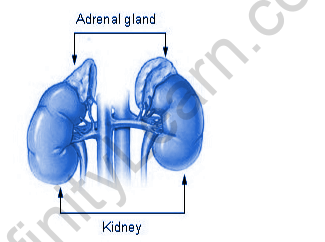Table of Contents

The location of the Adrenal Gland
Above each kidney are the adrenal glands. Even the word “adrenal” refers to where they are found: (Ad – “near” and renes – “kidneys” in Latin.) Suprarenal glands are another name for these glands.
The inferior vena cava and right lobe of the liver are located on the anterior side of the adrenal gland on the right. The right crus of the diaphragm faces the rear side. The abdomen, pancreas, and spleen are all located on the front of the adrenal gland. The left crus of the diaphragm faces the rear side.
Adrenal Gland Anatomy
The adrenal gland consists of two main regions.
First, there is the adrenal cortex, which is the largest and most external part of the prostate gland. It is further divided into three parts: the glomerulosa, the reticularis, and the fasciculata. Each of these components produces specific hormones in different parts of the body.
The second is the adrenal medulla, located in the middle of the adrenal gland, within the adrenal cortex. Stress hormones are released in this area.
The adrenal medulla is covered with a protective layer called the adipose capsule around the adrenal gland, as well as the adrenal cortex.
In addition, the right plate is in a pyramidal shape and much smaller than the left. The left gland is almost semilunar and the two glands are about 5×3 cm in size. A healthy pair of adrenal glands weigh between 7 and 10 grams and is yellow.
Parts of the Adrenal Glands
There are three distinct levels of adrenal glands:
- The Adrenal Capsule: Each adrenal gland is surrounded by a protective layer of fat called a capsule. Although this capsule layer is not part of the adrenal glands, its main role is to integrate and protect each adrenal gland.
- Adrenal Cortex: The adrenal cortex is the outer layer of the gland, which is responsible for the production of the hormones aldosterone, cortisol, and androgens. Beneath the microscope, there are three layers of cortex called areas that can be easily viewed and separated:
- Zona glomerulosa – Mineralocorticoids like aldosterone are produced.
- Zona fasciculata – Contains the production of corticosteroids such as cortisol. Low levels of androgens are also secreted (such as testosterone and androstenedione).
- Zona reticularis – Produces dehydroepiandrosterone (DHS) (also called androstenolone).
- The Adrenal Medulla: The medulla is the endothelial component of the adrenal gland. It stores Chromaffin cells, which produce catecholamines (such as adrenaline and noradrenaline) and body endorphins. In response to stress, they are stored and released.
Adrenal Gland Activity
- The chemical release of stress on the adrenal glands triggers one of the most popular responses, Fight or Flight Response.
- Various hormones are produced by the adrenal glands. These hormones are essential for the normal functioning of the body. The glands, for example, produce cortisol, an anti-inflammatory hormone that supports the immune system.
- Some hormones produced by the adrenal gland help regulate body temperature and blood pressure.
Adrenal Hormones
- Epinephrine: Commonly called adrenaline and acts as a stress hormone that raises heart rate and blood sugar levels.
- Norepinephrine: Also known as noradrenaline, is a stress hormone that works with epinephrine. Its main purpose is to improve the body and the mind.
- Hydrocortisone: It is a steroid hormone also known as cortisol. It is responsible for regulating biological functions such as the conversion of lipids and carbohydrates into energy, as well as other metabolic processes.
- Corticosterone: This hormone, combined with hydrocortisone, regulates the immune response and reduces inflammation.
Adrenal Gland Disorders
Adrenal gland diseases occur when the adrenal glands produce insufficient or absent hormones. Even deviant plants or plants have the potential to cause illness.
Here are some examples of Adrenal Disorders:
- Cushing’s Syndrome is a disease in which the levels of cortisol in the body are unusually high. A tumor on the adrenal gland or pituitary gland can be the cause.
- Adrenocortical carcinoma is a type of cancer that results from the outer layer of the adrenal gland. This type of tumor is commonly found many years after the spread of certain body parts.
- Congenital Adrenal Hyperplasia (CAH) is a genetic condition in which cortisol production is unusually low. People with this condition may have other hormonal imbalances, such as their body producing too much androgen but not enough aldosterone.
- Addison’s disease is caused by the production of insufficient cortisol or aldosterone by the adrenal glands. It causes weakness, fatigue, low blood pressure, nausea, and other symptoms. Addison’s disease is caused by 70% of cases of autoimmune disease in which the body mistakenly directs the adrenal glands. As a result, the adrenal gland produces insufficient amounts of the hormone aldosterone.
Also read: Important Topic Of Biology: Pancreas
FAQs
What is the Adrenal Gland and what does it do?
The adrenal glands are endocrine glands that produce important hormones needed for metabolic function and stress response.
Where is the adrenal gland?
Each kidney has its own set of adrenal glands.
What are the functions of the adrenal glands?
The adrenal glands play a role in metabolism, regulating blood pressure, and combating or reversing a flight.
What are the symptoms of adrenal gland dysfunction?
Adrenal gland problems are usually caused by the growth of a tumor. Abscesses can sometimes alter the production of essential hormones by speeding up or slowing down the process.
What is the role of the adrenal glands in the body?
Certain hormones are released into the bloodstream by the adrenal gland, which prepares the body for digestion. It also produces sex hormones and cortisol, both of which are essential for survival.





